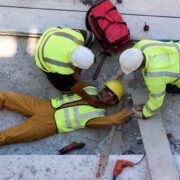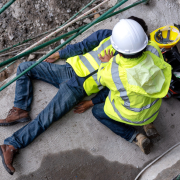Extreme Heat Increases Workplace Injuries, But New York Lacks Safety Standards
Construction workers take a break in the shade outside the Oculus at temperatures soar into the upper 90s. Ben Fractenberg/THE CITY | July 27, 2023
By Samantha Maldonaldo and Suhail Bhat | August 31, 2023
An analysis by THE CITY of workers compensation claims found thousands more workplace injuries, beyond those explicitly attributed to heat, on days 85 degrees or hotter.
When the temperature hits 85 degrees, workers in New York City are 7% more likely to be injured on the job. At 95 degrees, the likelihood of an accident goes up by one more point, to 8%.
That’s according to an analysis by THE CITY of hundreds of thousands of workers compensation claims filed with the state Workers’ Compensation Board between May and September from 2002 to 2022.
Heat stresses the body, can exacerbate heart and lung conditions and cause sickness and even death. While five states have laws on the books — and two more have regulations in the works — to protect workers in extreme heat, New York does not.
In Workers’ Compensation Board data, 420 injuries in New York City were explicitly attributed to heat since 2002. But THE CITY’s analysis suggests that the official count of incidents of injury associated with heat may be an undercount of the true toll: An additional 3,681 injuries happened on 85-degree-plus days between May and September, since 2015, in comparison to the rate of injuries on days below 85 degrees.
Both indoor and outdoor workers are affected by high temperatures. Construction workers see the most dramatic increases in injuries as the temperature climbs, with the likelihood of injuries for them up by more than 20% during 85-degree-plus days.
Workers in warehousing, waste management, manufacturing and food services also see increases in risk of an accident by 13% to 18%.
Andy, an assistant construction superintendent at a site of a future residential development in Crown Heights, Brooklyn, who declined to give his last name, said working in hot weather is difficult.
“It’s horrible, the heat you gotta deal with, constantly drinking water and constantly going to the bathroom because of all the water we drink,” he said. “If I see one of the guys starting to slow down, I tell him to go take a break. We’re trying to avoid the accidents.”
Besides experiencing heat strokes, workers in hotter temperatures were more likely to faint or pass out, suffer electric shock or get lacerations. About 20% of claims citing electric shock, fainting or passing out as the primary reason for injury have occurred on days that were 85 degrees or hotter.
No Heat Standards Yet
New York lacks any heat safety standards for workers, though seven states — California, Colorado, Maryland, Minnesota, Nevada, Oregon and Washington — already have them in place or in development.
A bill introduced this year in Albany proposes mandatory protections for people who work in construction, agriculture, landscaping, shipping, warehousing and food service.
State Sen. Jessica Ramos (D-Queens), a sponsor of the bill dubbed the TEMP Act, said in a statement that the measures required would help “avoid financial and physical strain on workers and employers alike.”
“These numbers present a bleak outlook for workers on the front line of the climate crisis,” Ramos said, referring to THE CITY’s analysis. “Passing TEMP has to be a priority for the legislature next session.”
Under the TEMP Act, which stands for Temperature Extreme Mitigation Program, worker protections would kick in when the temperature hits 80 degrees, and would escalate at 95 degrees. Employers would have to provide water, breaks, protective gear, and shade. They would have to allow new workers to acclimate, and would have to conduct training sessions and develop plans for addressing heat stress.
Andy, the construction superintendent, said he supports the aim of the law: “I don’t want to see anybody getting hurt.”
Even without any legal protections in place, Charlene Obernauer, executive director of the New York Committee for Occupational Safety and Health, suggested local municipalities conduct campaigns to educate employers on how injuries are more likely at higher temperatures.
“Employers could also proactively adopt policies that we’re recommending under TEMP, such as shade, rest, etcetera, and even could stop work if the weather is just too hot,” Obernauer said.
Earlier this summer, UPS and the Teamsters reached a tentative contract agreement that included a provision for the shipping company to install air conditions in trucks nationwide.
Some say that a unionized workforce is helpful to avoiding injuries.
“It is much safer to be working on a union construction job where you have shop stewards and union protection to ensure that you’re properly hydrated and you can get water breaks as needed,” said Chaz Rynkiewicz, vice president of Construction and General Building Laborers’ Local 79.
This story was published on August 31, 2023 by THE CITY.








Leave a Reply
Want to join the discussion?Feel free to contribute!